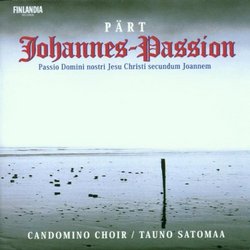Certainly not bach, but beautiful
p dizzle | augusta, georgia, USA | 09/20/2001
(4 out of 5 stars)
"arvo part is a modern master of contemplative classical music. at once avant garde, but at the same time rooted in centuries old traditions, he constructs new music that does not rely on dissonance or atonality, but sends familiar forms into new directions. here he tackles the passion narrative of the gospel of john. done in latin, the listener will probably have to follow along with the provided libretto in the liner notes if they want to follow the gospel narrative. however, this is not necessary. part creates a soundscape that at once communicates the depth and spirituality of the passion narrative. he employs ancient forms (renaissance vocal groupings and structures) that somehow get the point across-- the death of jesus is a deeply profound moment that no one quite understood nor has a handle on even now. the latin symbolically emphasizes the mystery of the passion, yet the music is emotive drawing the listener in through something other than intellect, which in the end is true of any faith expression. this is a wonderful work, well worth repeated listens."
A new way of listening to music
Leonardo | Argentina | 02/24/2005
(5 out of 5 stars)
"Name your favourite composer. Name the composer you dislike most. Name another composer with works you like or love. No matter you choose (exception those who compose like Part's) baroque, Renaissance, Classical, romantic, most of XXth century... all "serious" "academic" (opposed to "popular")music, I think, is based in expansion. Take one or more motifs and expand them, make variations, change colours. A reference exemple is the beggining of Beethoven's fifth symphony: the opening motif is a stupid tatatataaa - tatatataaa. But see what LvB does: a (7) minute movement or perfectly coordinated expansion of this motif (of course there is a second subject but I stress how he develops the motif).
And then throw centuries of knowledge into the trash can. Oh man, you have to have more than a good pair of testicles to do that!! For here you have 60 minutes of the same musical motif in the Evangelist part. Boring? If you listen with this thinking frame (expansion-and-variety), of ccourse. But this gem requests you to be patient. And be engulfed by its ascetic, trascendent beauty. Here variety is achieved by contrasts of textures, and it is achieved in the details. It is a sad work, of course, but which enlightens you at the end. If you want something original, please don't buy a new Schubert chamber work, a new Beethoven piano sonata or Mozart opera. I think anyone which is thinking in buying Part already has the esentials by those great composers. You musical library will expand a lot, more conceptually than in quantity, with this set, rather than with another famous composer's work, because Part, with silence, defies the very basic way of musical thinking which lies beneath apparently different musical periods. I'm not saying this is the first work to do that but here we talk about SJP. To give space to this CD in your library requires a good dosis of courage. It is worth investigating.
About the performance: seems good to me. I don't know the Naxos and the ECM sets."


 Track Listings (10) - Disc #1
Track Listings (10) - Disc #1